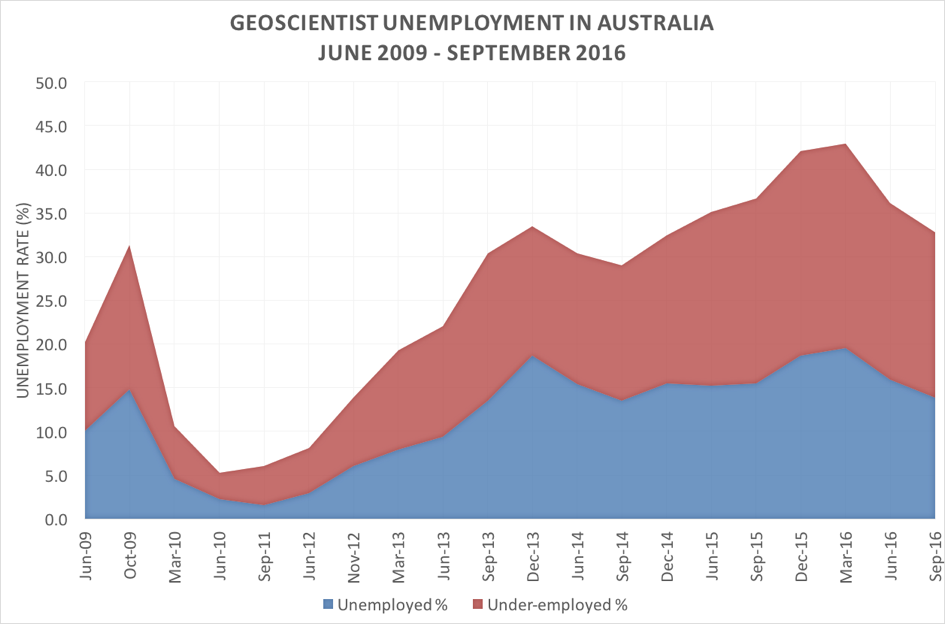In a promising sign for the industry globally, the Australian Institute of Geoscientists (AIG) reports employment prospects for Australia’s professional geoscientists continued to improve gradually in the three months between end June and end September 2016. The picture emerged in results of the latest quarterly survey by the AIG in which respondents provided information about their employment prospects during the September quarter of 2016.
At September 30 2016, the unemployment rate amongst Australian geoscientists was 13.9% and the under-employment rate was 18.9% , as shown in the figure.
The unemployment rate fell 2%, from 15.9% at the end of June and the underemployed rate fell by only 1.3% from 20.2% to 18.9% for the same period. Almost 55% of self-employed geoscientists were unable to secure more than one quarter of their desired workload during the quarter, pointing to a real unemployment rate of 24.2%, down from 27.6% at the end of June.
The employment survey results for different states were again mixed. The highest combined rate of unemployment and underemployment was evident in South Australia, followed by New South Wales/ACT. The low levels of unemployment and underemployment in the Northern Territory reflect a small sample and, potentially, a contraction in exploration and mining activity.
The Northern Territory aside, the greatest decrease in geoscientist unemployment was evident in Queensland, where the unemployment and under-employment rates fell by 5.5% and 3.2% respectively. Queensland and the Northern Territory were the only states in which unemployment and underemployment fell. New South Wales was the only state in which unemployment increased.
More than 58% of unemployed and underemployed geoscientists have been without work for more than 12 months. Long term unemployment amongst geoscientists continues to be a serious and persistent issue. The proportion of geoscientists who have been unemployed for more than 12 months is essentially unchanged from the previous survey.
Some 48% of unemployed and under-employed geoscientists said that they were not confident of regaining their desired level of employment within the next 12 months.
More than 80% of unemployed and under-employed geoscientists were seeking to return to their profession when circumstances permit, while 5% were looking to leave their profession and seek employment in another field.
Amongst geoscientists currently in employment, more than 88% were confident of retaining employment for more than 12 months and almost 11% returned to full employment in the September quarter following a period of unemployment. More than a quarter of employed respondents reported that their employment conditions had improved during the September quarter, 57% reported no change in employment conditions while almost 17% reported that their employment conditions had declined.
Almost 64% of survey respondents worked, or are seeking work in exploration and mining. A further 14% work in metalliferous mining, and almost 5% in energy resource exploration and production. Almost 6% of Australian geoscientists now work in engineering, environmental and groundwater resource management geology. About 4.5% of Australian geoscientists work in government roles.
For the first time, the survey asked respondents to state their gender. About 84% of respondents were male, 16% female. The unemployment rate amongst female geoscientists was 9.4% and the underemployment rate 15.9% (compared with 13.9% and 18.9% respectively for the profession generally). Women are best represented amongst geoscientists with less than 15 years experience.
This trend potentially reflects more women taking up geoscience as a career over the last 15 years than previously.
The lack of geoscientists with 15 to 20 years of experience is interpreted to be an outcome of the downturn in Australia’s exploration and mining industry in the late 1990s-early 2000s, as does the dip in the curves at 25-30 years of experience.
Figures also suggest that Australia’s geoscientists are ageing, with 25% to 30% having 30 years or more experience, who would be in their early to mid-fifties and within 10 to 15 years of retirement. This poses a challenge for the profession in ensuring that skills and experience amassed by more experienced geoscientists are passed on to early career professionals, something which AIG is addressing in a structured and considered manner through an evolving, formal mentoring program in which all members are able to participate as either mentors or mentees.
“Two successive quarters of improved employment prospects for geoscientists in Australia is most welcome” said AIG Council member Andrew Waltho. “We haven’t seen that since September 2014 but Australia’s geoscientists are far from out of the woods as far as employment is concerned. There has ben growing anecdotal evidence that the situation for geoscientists has been improving as the exploration and mining sectors recover from what has been a prolonged and damaging downturn.
“The impacts of recent commodities prices probably came too late to be reflected in this survey but we will be keenly watching the results of the next survey in December” Waltho said. “These results still show uncertainty in the sector, with decreases in unemployment being matched by increases in under-employment for self-employed geoscientists in most states. Any improvement in the employment situation is most welcome.”











